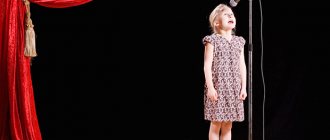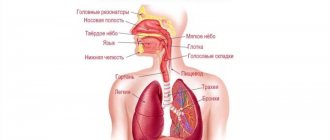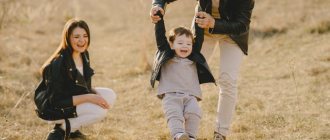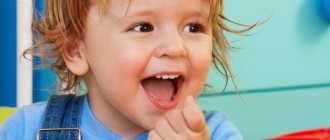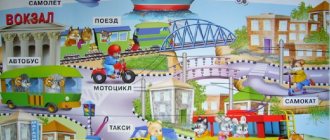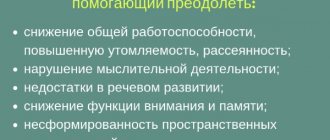Logorhythmic games for children 4-5 years old
By the age of 4-5 years, the final development of speech occurs. It is important to pay great attention to the pronunciation of sounds and strengthening the articulation of sounds. Therefore, speech therapy exercises at this age occupy a special place.
The horse runs tsk-tsk-tsk, (clicking movements of the tongue from the palate)
A bird chirps in a field. (same clicking noise but from teeth)
A friend is sitting on the bank (smile, teeth unclenched)
And catches a fish in the sea (they close and straighten their lips)
Breathing continues to develop. Speech breathing should be distinguished from the general one. You can perform exercises for alternating short and deep breathing:
Doll Masha wants to sleep. (inhale through your nose, exhale with a drawn-out sound “ahhhh”)
Let's sing her a song. (inhale through the nose, on one exhale repeat the syllable “la-la-la” three times)
Doll Masha fell asleep. (sniffle)
The right time for such exercises would be gymnastics after an hour of sleep. Together with general motor skills, fine motor skills are actively developing. It is worth adding acting skills to logorhythmic games and exercises, teaching children to get used to the role and operate with various phrases:
- I am a cheerful cockerel (inhale, exhale “ko-ko-ko”)
I have a comb. (shake head)
— I am a frowning turkey (inhale, exhale “pa-pa-pa”)
I'm looking for grains bale-bale (tilt my head as if pecking at the grains)
- I’m a mischievous horse (clicking tongue from the roof of your mouth)
Golden tail and mane (shake your head)
The expressiveness of movements should correspond to the emotional state of the hero. Children learn to manage their emotions and express them correctly. You can change the exercise words as you play. Let the children do it themselves, do not interfere with their imagination. When the children learn the words, let each of them do the exercises one by one.
Game 1
A good game would be to guess your classmates. It develops tactile sensations, general motor skills and rhythm: children stand in a circle, and one child in the center. He is blindfolded. The children begin to walk in circles. The teacher says “stop” and the children stop. The child in the center of the circle approaches one of the children in the outer circle and guesses who it is.
Game 2
A popular game for this age is “Sea Figure, Freeze!” Children take on the role, play actively, learn to listen to music and quickly respond to brake lights. Freezing in certain positions reinforces knowledge about the capabilities of your body.
Logorhythmic games and exercises for children 5-6 years old
At this age, children, as a rule, already speak well and know how to control their body. The child's body is full of strength and energy. Active games and exercises that require physical effort are suitable. To prepare for beautiful handwriting, logarithmic exercises for fine motor skills and self-massage (rubbing palms, fingers, acupressure exercises) are used.
It’s not for nothing that winter is angry, (shaking index finger)
Its time has passed. (rubbing palms)
Spring is knocking on the window (knock on the palm with a finger)
And drives them out of the yard (waving their arms, driving away winter) (F. I. Tyutchev)
Logorhythmics at this age should be aimed at developing a sense of rhythm and emotion in speech, and correct intonation. At 5-6 years old, you need to teach your child smooth speech and voice, and continue to develop breathing. During the year there is active preparation for school. With the help of logorhythmic exercises, attention and concentration are developed.
Transitions of music tempos from slow to fast and back are relevant at this age. To gain a sense of rhythm and tempo, you can let children play musical instruments themselves and beat out a simple rhythm together, for example, on spoons and tambourines. In the older group, exercises are of a regulatory nature. Teach children independence. Exercises where the child himself must guess what movement needs to be made at the moment are well suited for these purposes. For example, when you hear the words “snowflakes are spinning,” you need to spin around with your arms out to the sides:
All the snowflakes are whirling in the wind, (whirling)
Without doubts and worries. (jump, breathe through their nose)
So we guys are together (holding hands)
Together we will stand in a round dance (they walk a circle in a round dance) (M. A. Mordvin)
The help of a teacher is required when performing the exercises for the first time.
Why and what children need it?
Parents are not always able to independently determine that their child requires correction. There are children who quickly and actively develop in all directions, and there are those who cannot keep up with their peers without outside help. That is why the education system is selected individually for each child.
But at the age of 2-3 years, logorhythmics is absolutely necessary for those children who have:
- stuttering;
- slow pace of speech;
- dysarthria or a specialist has diagnosed RRD;
- poor orientation in space;
- poor development of motor skills.
Logorhythmic games for children who stutter
Logorhythmic exercises for children with stuttering include complexes that strengthen muscle tone, articulation, and diaphragmatic breathing. All exercises must be agreed upon with a speech therapist. Children with speech impairments require a special approach, cannot master musical exercises in full, and require repeated repetition of rhymes and songs. Be sure to pronounce each sound:
The children have a doll in their hands. They clearly pronounce the sounds with the correlation of the action in verse to the doll:
Masha washed Mila with soap.
Exercise:
We put a lock: (smile, teeth closed)
The tongue couldn't get through. (tongue rests on teeth)
The main goal of such games for children with stuttering is to develop the tempo of speech, the rhythm of movements, the smoothness of the voice and coordination in a static and dynamic position. In addition to the speech therapy part, the classes are socially adaptive in nature. They teach behavior in a team, develop the emotional-volitional sphere. This includes activities that transition from a slow walk to running:
Early in the morning they go to visit -
Only best friends. (hugs with a classmate standing next to him)
Turtle with a thick cane
It was not in vain that I set off on my journey. (slowly raise their legs, imitate a step)
The little squirrel called all the animals,
I distributed invitations. (bows in different directions)
Mouse, bear and little rabbit (mouse - walk on tiptoes, bear - clumsily, little rabbit - jump)
They dressed up like they were going to a ball. (make a bell with your hands)
The fox is running as fast as he can - (imitate running)
After all, you can't be late. (they shake their index fingers alternately)
To dance around
Sliding smoothly across the floor. (spinning)
(M. A. Mordvin)
From smooth hand movements to fast ones:
They barely tilt
They ate the tops of their heads straight to the ground. (slowly swing your arms up and down while leaning forward)
A bird flutters in the sky,
Like an eyelash above an eye (stand on tiptoes, quickly wave your arms)
(M. A. Mordvin)
It is advisable to perform the exercises with a music teacher accompanied by live music that is not distorted by the recording. Acting games are performed together with the teacher. First, collective performances or performances without the children’s words are performed, then each child is invited to learn his own words and act out a short story. Words must be selected strictly according to the characteristics of each child and have a focus on those parts of pronunciation that require increased attention. Thus, a collective lesson turns into an individual one.
Relaxation exercises are performed in conjunction with exercises that require increased load. Such games and activities should alternate. The relaxation exercise should be proportionally equal to the load received by the children in the previous game.
Classes
Zheleznova’s logorhythmics were specially developed for children 2-3 years old. It is presented in a playful way, which will help the child in the company of other peers to significantly accelerate the acquisition of speech skills.
More often, a kindergarten takes on the function of teaching children logarithmics, but parents should also get involved in the training in order to consolidate the achieved results at home. Special exercises and games carried out at home will not take much time and will bring positivity to the family.
Zheleznova’s logorhythmics helps achieve the following goals:
- correct and train speech skills;
- carry out a complete recovery of the child’s body;
- develop proper breathing;
- improve coordination;
- improve aesthetic education;
- improve your sense of rhythm.
Zheleznova’s logorhythmics for children 2-3 years old involves the use of music, which allows further development of phonetic hearing. Simple and understandable songs about a bus, a bear, a spider, are composed in such a way as to maximally work out each muscle responsible for articulation.
A classic lesson using the Zheleznova method should consist of the following steps:
- greetings;
- warm-up;
- games involving gestures and finger exercises;
- massage in the form of a game;
- gymnastics to music;
- logorhythmics;
- chanting and singing;
- fairy tales;
- parting.
On average, one lesson should last no more than 45 minutes, otherwise the child will get tired and will not complete the entire program.
Bus
This exercise must be performed on a ball.
Speech therapist says:
- Here we are sitting on the bus, and sitting, and sitting.
At this time, the children slowly sway from side to side on the ball.
- And we look out of the window, we all look!
Children raise their hands and close their fingers in the shape of a window, then look out of it, turning first one way or the other.
- We look back, we look forward, like this, like this.
Children make turns in one direction or the other, peering into the distance from under their palms.
- Well, the bus is not lucky, is it not lucky?
A shrug is performed.
- The wheels started spinning like this, like this, we rolled forward like this!
At this time, children perform circular movements with their arms in front of them.
- And the brushes rustle on the glass, whack-whack-whack, whack-whack-whack,
- All the droplets want to sweep away whack-whack-whack!
Swinging is performed with arms bent at the elbows, which imitate the work of windshield wipers.
- And it’s not just that we sit, turn the steering wheel and beep: beep-beep-beep, beep-beep-beep,
- We all hum loudly and loudly: beep-beep-beep!
- Let the bus shake us like this, like this,
- We are moving and moving forward just like that!
Everyone is actively jumping on balls.
Beanbag
- Rattle, rattle, musical toy.
- If you want, take two at once and rattle, rattle, rattle,
- If you want, take two at once and rattle, rattle, rattle.
- Hide the rattle behind your back, your ears will rest from the noise,
- Look at your neighbor and sit quietly,
- Look at your neighbor and sit quietly.
Watch
Speech therapist says:
We sit on a rug or pillow (on our knees). We move our fingers (“run”) from the knees to the top of the head.
- The mouse climbed for the first time
- See what time it is.
- Suddenly the clock said: “Bang!”
Children perform one clap above their heads.
- The mouse rolled head over heels.
Children put their hands on the floor.
- The mouse climbed in a second time
- See what time it is
- Suddenly the clock said: “Bom, bom!”
Children perform 2 claps.
- The mouse rolled head over heels.
- The mouse climbed for the third time
- See what time it is.
- Suddenly the clock said: “Bom, bom, bom!”
Children perform 3 claps.
- The mouse rolled head over heels.
Little frogs
- Four frogs are sitting together on a stump,
- They sit on a stump together and eat delicious worms:
- Yum-yum, yum-yum, yum-yum-yum-yum-yum-yum!
- Yum-yum, yum-yum, yum-yum-yum-yum-yum-yum!
- Suddenly one dived into a puddle, fell asleep in the warm water,
- And three frogs eat delicious worms:
- Om-Nom-nom…
- Suddenly one dived into a puddle, fell asleep in the warm water,
- And two frogs eat delicious worms:
- Om-Nom-nom…
- Suddenly he dived into a puddle and fell asleep in the warm water.
- The latter still sits and looks at the worms.
Warm-up
When pronouncing the words of the song, the child must repeat the movements indicated in it:
- We nod our heads,
- Let's shake our noses,
- And let's knock our teeth
- And let's be silent for a while.
- We'll roll our shoulders
- And let's not forget about the pens,
- Let's shake our fingers
- And let's rest a little.
- We'll kick our feet
- And let's squat a little
- Let's match a leg with a leg
- And let's start all over again...
Our pens
Speech therapist says:
- Our hands are dirty, let's wash them with warm water.
- We wash our hands like this, like this.
Children imitate hand washing.
The speech therapist continues:
- We raise our hands, like this, like this.
- We raise our hands up, fingers spread out, and turn the “lanterns” over.
- We lower our arms like this, like this.
- We lower our hands, fingers spread, and turn the “lanterns” over.
- And we put it behind our back like this, like this.
Children put their hands behind their backs.
I want to build a house
- I want to build a house
- So that there is a window in it,
- So that the house has a door,
- Nearby for a pine tree to grow.
- So that there is a fence around
- The dog guarded the gate,
- So that a bug lives on the grass,
- He ran fast p-u-check.
- I want to build a house
- So that there is a window in it,
- So that the house has a door,
- Nearby for a pine tree to grow.
- It was sunny, it was raining,
- So that the tulip blooms in the garden,
- So that there is a flag on the house,
- And behind the house there lived a hedgehog.
Bunny
- The bunny jumped, jumped, jumped, jumped and got tired.
Children are jumping.
- He wiggled his tail.
Children drive the body.
- He raised his ears up.
Lesson on logorhythmics (Zheleznova system for children 2-3 years old).
Exercise - “Bunny” Children use their hands to depict bunny ears above their heads.
- The bunny jumped, jumped, jumped, jumped and got tired.
Children are jumping.
- He wiggled his tail.
Children drive the body.
- He raised his ears up.
Children use their hands to depict bunny ears above their heads.
- And the bunny heard a quiet, very quiet sound.
Children put their hand to their right ear and turn to the right, as well as to the left.
- I looked around.
Children make a “visor” over their eyes with their hands, turn to the right and also to the left.
- He suddenly jumped into the hole.
Children bounce in place or jump forward.
In giraffes
Before the game, the speech therapist asks the child to talk about what a giraffe, elephant, zebra, and cat look like.
You need to show them pictures of these animals, noting their characteristic external features:
- the giraffe has spots;
- the elephant has folds;
- the kitten has fur;
- The zebra has stripes.
Next, the speech therapist reinforces the words with gestures that will be used in the game:
- Giraffes have spots, we clap our hands all over the body.
- Elephants have folds, we “collect the folds”, we pinch ourselves.
- Kittens have fur, let's stroke ourselves.
- And the zebra has stripes, we run our fingers or the edge of our palm along the body.
During the chorus, children point with their index fingers at the named body parts.
Together with us
- You clap with us: clap and clap.
- You clap with us: clap and clap.
- You clap with us, you clap with us.
- You clap with us: clap and clap.
- You stomp along with us: stomp and stomp...
- You jump with us: jump and jump...
- And now you will dance with us,
- And now you will dance with us,
- And now you will be with us, and now you will be with us,
- And now you will dance with us.
To get real, lasting and quick results, you should follow several important rules:
| Rules | Peculiarities |
| Correct load formation | Select the load for the child according to his age. |
| Choose the right class time | The best time for classes is in the afternoon, after the child has had lunch and rested. |
| Change the topic of the lesson | Try to select different topics for classes every week, then it will be more interesting for the child. |
| Correctly selected material | When selecting, it is important to focus on lexical topics. |
| Diversify the material | Try to organize the lesson correctly, add scenes from fairy tales or cartoons to make it more interesting for the child to perform speech and musical exercises. |
| Regularity | You need to work with your child every day. |
| Show movements correctly | Try to show all the movements correctly, pronounce the words of the songs so that the child understands everything. |
Logorhythmics by Zheleznova is a unique author’s program that includes musical, speech and physical exercises. Children aged 2-3 years enjoy dancing, singing and imitating different sounds, improving their speech, improving motor function and becoming completely healthy.
It is very important to remember that results can only be achieved if logarithmics are performed regularly.
